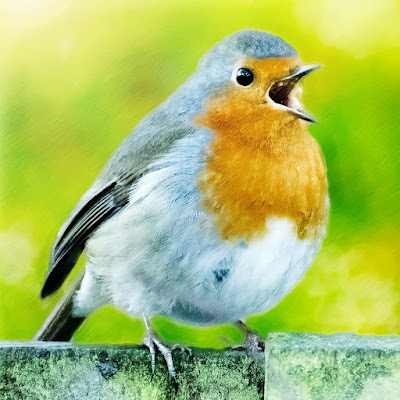Birdsong refers to the musical or melodic sounds that birds produce as a form of communication, often used for attracting mates, defending territory, or signaling danger. Birds have a specialized vocal organ called the syrinx, which allows them to produce a wide range of sounds and complex vocalizations.
Birdsong varies greatly between different species of birds, and can be characterized by its rhythm, pitch, and pattern.
Most likely, when you hear a bird singing, it is a male trying to attract a mate or mark his territory. However, female birds in certain regions such as the tropics, Australia, and South Africa, sing more frequently than their counterparts in other parts of the world.
Birds sing in the morning to get the clearest, crispest sound quality they can.
The morning singing of birds is called the "dawn chorus". It is mostly male birds that sing in the morning and it is theorized that they do so to show fitness, the air and low ambient noise allows for clearer signal, and it's too dark to really do anything else.
Birds are not born with the ability to sing; they learn their songs in the nest.
While some birds have a limited repertoire of just one song, others have an impressive repertoire of up to 2,000 songs.
Some birds are renowned for their complex and intricate songs, such as the nightingale or the mockingbird, while others produce more simple and repetitive calls.
The songs of many bird species are highly complex and can contain dozens of notes per second. Songbirds may take as many as 30 mini breaths per second to keep up their tune.
True songbirds exhibit a wide range of songs, from the simple two-note song of the chiffchaff to the complex 103-note phrase (sung in as little as 8.25 seconds) of the wren.
In some bird species, particularly those in the tropics, male and female birds sing together in duets.
Research has revealed that British songbirds have distinct dialects, with variations in pitch, tone, and tune based on the region in which they live. It is believed that these regional accents help reduce the likelihood of birds mating with those from other regions.
In the 1930's an Australian farmer/flute player released his pet lyrebird into the wild, which was able to mimic certain phrases of the man's music. The bird has shared the music with other lyrebirds and the same melodies are still sung by these birds today.
CBS used to add bird songs to their golf broadcasts to get rid of awkward silences until they got caught by someone watching at home who knew the bird songs belonged to birds that didn’t live in the region in which the golf tournament was being played.
BIRDSONG IN THE MEDIA
The Let Nature Sing project, launched by the Royal Society for the Protection of Birds (RSPB), aimed to raise awareness of the decline in Britain's birdlife by incorporating birdsong into the United Kingdom music charts. Adrian Thomas, a renowned expert in birdsong, recorded a series of birds singing between 2016 and January 2019 for this project. Folk singer Sam Lee and Shakespeare's Globe music director Bill Barclay collaborated to compile the resulting track, "Let Nature Sing," which features 25 different threatened and endangered United Kingdom birds and runs for two and a half minutes.
"Let Nature Sing" became the first track featuring only birdsong to chart in the United Kingdom, debuting at #18 on May 5, 2019. While some songs like "Lovin' You" by Minnie Riperton, "Birds" by Bic Runga, "Morning Mr. Magpie" by Radiohead, and "Unknown Caller" by U2 include birdsong in their mix, "Let Nature Sing" is unique in featuring pure birdsong.
Kate Bush's 2005 Aerial album's second CD is also noteworthy for its abundant use of birdsong, particularly the title track.
Source Daily Express

No comments:
Post a Comment